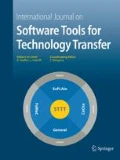Abstract
The next generation airborne collision avoidance system, ACAS X, departs from the traditional deterministic model on which the current system, TCAS, is based. To increase robustness, ACAS X relies on probabilistic models to represent the various sources of uncertainty. The work reported in this paper identifies verification challenges for ACAS X, and studies the applicability of probabilistic verification and synthesis techniques in addressing these challenges. Due to shortcomings of off-the-shelf probabilistic analysis tools, we developed a new framework, named VeriCA (Verification for Collision Avoidance). VeriCA is a combined probabilistic synthesis and verification framework that is custom designed for ACAS X and systems with similar characteristics. VeriCA supports Java as a modeling language, is memory efficient, employs parallelization, and provides an interactive simulator that displays aircraft encounters and the corresponding ACAS X behavior. We describe the application of our framework to ACAS X, together with the results and recommendations that our analysis produced.
















Similar content being viewed by others
Notes
As explained in [9], the advisory response is determined according to a Bernoulli process, so the delay until response follows a geometric distribution. If the response probability at each step in the process is \(\frac{1}{1+k}\), then the mean time until response is k.
References
Chatterjee, K., Majumdar, R., Henzinger, T.A.: Markov decision processes with multiple objectives. In: STACS 2006, 23rd Annual Symposium on Theoretical Aspects of Computer Science, Marseille, France, February 23–25, 2006, pp. 325–336 (2006)
Forejt, V., Kwiatkowska, M., Parker, D.: Pareto curves for probabilistic model checking. In: Chakraborty, S., Mukund, M. (eds.) Proc. 10th International Symposium on Automated Technology for Verification and Analysis (ATVA’12), volume 7561 of LNCS, pp. 317–332. Springer (2012)
Galdino, A.L., Muñoz, C., Ayala-Rincón, M.: Formal verification of an optimal air traffic conflict resolution and recovery algorithm. In: Logic, Language, Information and Computation, 14th International Workshop, WoLLIC 2007, Rio de Janeiro, Brazil, July 2–5, 2007, pp. 177–188 (2007)
Ghorbal, K., Jeannin, J., Zawadzki, E., Platzer, A., Gordon, G.J., Capell, P.: Hybrid theorem proving of aerospace systems: Applications and challenges. J. Aerospace Inf. Sys. 11(10), 702–713 (2014)
Hansson, H., Jonsson, B.: A logic for reasoning about time and reliability. Formal Aspects Comp. 6, 102–111 (1994)
Jeannin, J., Ghorbal, K., Kouskoulas, Y., Gardner, R., Schmidt, A., Zawadzki, E., Platzer, A.: A formally verified hybrid system for the next-generation airborne collision avoidance system. In: Tools and Algorithms for the Construction and Analysis of Systems - 21st International Conference, TACAS 2015, Held as Part of the European Joint Conferences on Theory and Practice of Software, ETAPS 2015, London, UK, April 11–18, 2015, pp. 21–36 (2015)
Julier, S.J., Uhlmann, J.K.: Unscented filtering and nonlinear estimation. Proc. IEEE 92(3), 401–422 (2004)
Katoen, J., Zapreev, I.S., Hahn, E.M., Hermanns, H., Jansen, D.N.: The ins and outs of the probabilistic model checker MRMC. Perform. Eval. 68(2), 90–104 (2011)
Kochenderfer, M.J.: Decision making under uncertainty: theory and application. MIT Press, Cambridge (2015). Please cehck and confirm the publisher location is correct and amend if necessary
Kochenderfer, M.J., Chryssanthacopoulos, J.P.: Robust airborne collision avoidance through dynamic programming. Project Report ATC-371, Massachusetts Institute of Technology, Lincoln Laboratory (2011)
Kuchar, J., Drumm, A.C.: The traffic alert and collision avoidance system. Lincoln Lab. J. 16(2), 277 (2007)
Kwiatkowska, M.Z., Norman, G., Parker. D.: PRISM 4.0: Verification of probabilistic real-time systems. In: Computer Aided Verification - 23rd International Conference, CAV 2011, Snowbird, UT, USA, July 14–20, 2011, pp. 585–591 (2011)
Loos, S.M., Renshaw, D.W., Platzer, A.: Formal verification of distributed aircraft controllers. In: Proceedings of the 16th international conference on Hybrid systems: computation and control, HSCC 2013, April 8–11, 2013, Philadelphia, PA, USA, pp. 125–130 (2013)
Lygeros, J., Lynch, N.: On the formal verification of the TCAS conflict resolution algorithms. In: 36th IEEE Conference on Decision and Control, pp. 1829–1834 (1997)
Platzer, A., Clarke E.M.: Formal verification of curved flight collision avoidance maneuvers: A case study. In: FM 2009: Formal Methods, Second World Congress, Eindhoven, The Netherlands, November 2–6, 2009, pp. 547–562 (2009)
Rennen, G., van Dam, E.R., den Hertog, D.: Enhancement of sandwich algorithms for approximating higher-dimensional convex Pareto sets. INFORMS J. Comp. 23(4), 493–517 (2011)
Tomlin, C., Pappas, G.J., Sastry, S.: Conflict resolution for air traffic management: A study in multiagent hybrid systems. IEEE Trans. Auto. Cont. 43(4), 509–521 (1998)
von Essen C.: Quantitative Verification and Synthesis. PhD Thesis, Université Joseph Fourier, Grenoble, France (2014)
von Essen, C., Giannakopoulou, D.: Analyzing the next generation airborne collision avoidance system. In: Tools and Algorithms for the Construction and Analysis of Systems - 20th International Conference, TACAS 2014, Held as Part of the European Joint Conferences on Theory and Practice of Software, ETAPS 2014, Grenoble, France, April 5–13, 2014, pp. 620–635 (2014)
Zuliani, P., Platzer, A., Clarke, E.M.: Bayesian statistical model checking with application to Stateflow/Simulink verification. Formal Methods Syst. Design 43(2), 338–367 (2013)
Acknowledgments
We wish to thank Neal Suchy of the FAA for being supportive of this work and putting us in contact with ACAS X team members. In particular, Mykel Kochenderfer helped us ensure that our ACAS X model was faithful to the one in the published version, and Ryan Gardner and Yanni Kouskoulas helped us identify verification and synthesis challenges through extensive discussions. Finally, we thank Guillaume Brat for providing technical feedback for this work, and Johann Schumann, Mykel Kochenderfer, and Ryan Gardner for proof-reading the paper. The work was funded under the System-wide Safety Analysis Technologies Project of the Aviation Safety Program in NASA ARMD.
Author information
Authors and Affiliations
Corresponding author
Additional information
The first author performed this work while employed by SGT Inc. as an intern at the NASA Ames Research Center. He is currently employed by Google, Zurich.
Rights and permissions
About this article
Cite this article
von Essen, C., Giannakopoulou, D. Probabilistic verification and synthesis of the next generation airborne collision avoidance system. Int J Softw Tools Technol Transfer 18, 227–243 (2016). https://doi.org/10.1007/s10009-015-0388-8
Published:
Issue Date:
DOI: https://doi.org/10.1007/s10009-015-0388-8




